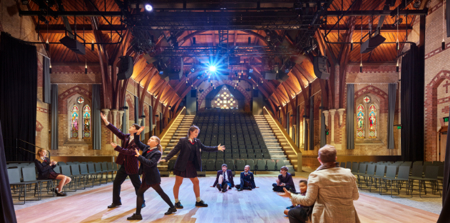

St George's Performing Arts Centre
Kneeler Design Architects
Agency: Kneeler Design Architects
Client: St Michael's Grammar School
Kneeler Design Architects (KDA) engaged with staff and students throughout the design process to ensure the project was grounded in the school's values and met their aims for improved teaching and learning outcomes. A key ambition of the project was to maximise seating numbers yet maintain good sightlines to the stage. KDA worked closely with a heritage consultant to develop the design in accordance with the Burra Charter process and Heritage Victoria guidelines, ensuring a balance between heritage and educational objectives. The design takes the form of strategic insertions and interventions that lightly touch the building fabric, so that the church's spatial and material qualities are preserved. No new openings could be made in the fabric to allow access for machinery or scaffolding, resulting in a complex construction methodology that involved all building components entering through the existing narrow doorways and being assembled within the building. The key intervention—a multifunctional brass 'ingot' cast in the nave—houses tiered seating, a control desk, box office-cum-learning studio, wet bar, storage, and undercroft plant room to maximise the use and value of the limited space. The sides of the 'ingot' are perforated for mechanical ventilation, with the main air intake fan unobtrusively integrated into the existing bell tower. Key heritage features like the stained glass windows and organ were expertly restored, while significant joinery elements were retained or repurposed as interpretive displays. Washroom and change facilities are provided through prefabricated relocatables and a covered walkway set back from the existing building, ensuring that the principal façade remains dominant from the street. The church's cruciform plan informed the thrust stage configuration—the audience is seated on three sides of the new sprung stage floor that supports a myriad of performance styles. New steelwork, engineered to be suspended from the existing timber roof trusses, support stage machinery, acoustic reflectors, and drapes to allow flexible subdivision of the stage in various configurations. Careful coordination with services and theatre consultants allowed ductwork and conduits to be mostly concealed in the subfloor space to minimise their visual impact. The integration of cutting-edge audiovisual technologies, including an L-Acoustics L-ISA immersive audio system and modular video wall, overcomes the acoustic and scenographic limitations of the heritage fabric and empowers students to reimagine performing arts in an unconventional theatre environment. The built outcome remains a recognisably ecclesiastical space while providing a visually exciting, immersive theatrical atmosphere for audience and performers alike, honouring the building’s past while equipping it to help shape present and future generations of performing arts talent.